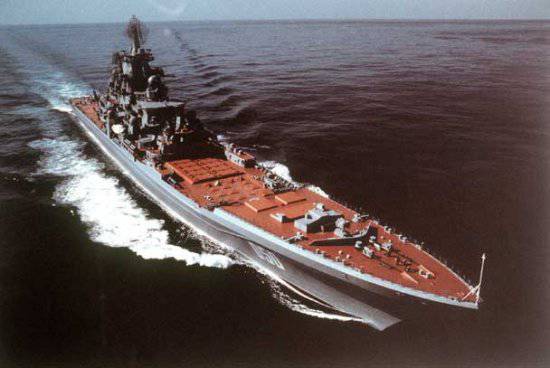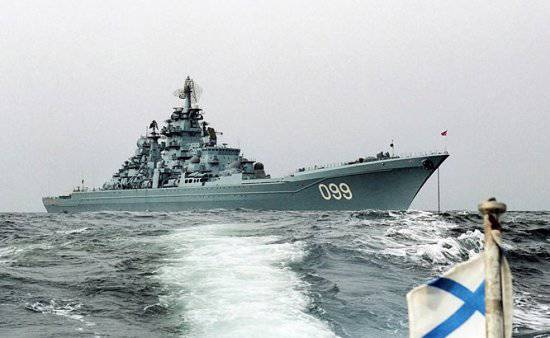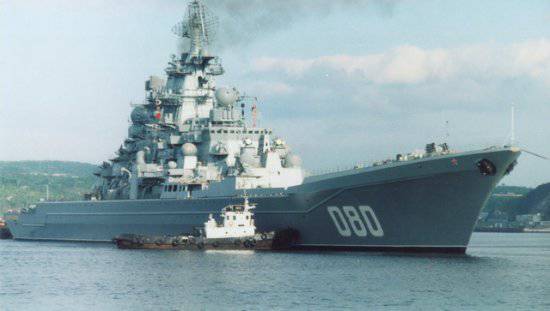Moment of truth for "aircraft carrier killers"
During the 2000s, the fate of the Soviet 1144 cruisers seemed decided. The three oldest ships in the series, withdrawn from the Russian Navy for modernization as early as the end of 90, were silently “written off” by public opinion. The Internet was filled with photographs of an unkempt, rusty “iron” that had quietly faded away in the navy sludge. Here and there, voices of “informed” people were heard, reporting that from next year the ships were already precisely assigned to cutting into metal and they have no prospect.
This year, it seems, the situation has changed radically. Officially announced the decision to return these ships after a radical modernization of the Navy. As far as can be judged by the scanty comments of the leadership of its High Commander Committee, the upcoming improvements will seriously change the very concept of cruisers, significantly affecting their future role in the composition of the new Russian fleet.
Non-wide profile tool
The doctrine of the construction of the Soviet Navy from the end of the 60-ies is inextricably linked with the name of its commander-in-chief, Admiral Sergey Gorshkov. The author of the program book “Sea Power of the State”, carefully studied in the naval academies of all the major powers of the world, assessing the unhappy prospects of the naval arms race with all the “aggressive NATO bloc” and China in addition, decided and struck at the very top the decision on an “asymmetric response "- building a fleet around the anti-aircraft component.
Words like “asymmetrical response” or “unique, unparalleled in the world” generally sound very often when they refer to the late period of development of the USSR military-industrial complex. It should be understood that the “asymmetry” of such answers, as a rule, arose not from a good economic and geopolitical situation, but “uniqueness” was rooted in industrial and technological specifics and weakness of the infrastructure, which prevented the development of large-scale production and operation of products designed on the basis of “standard »Solutions. Nevertheless, the "uniqueness" often cost much more expensive. Suffice it to recall, for example, six strategic missile carriers of the 941 project — stunning imagination of underwater giants, who fell victim to the inability of the Soviet defense industry to create compact solid-fuel ballistic complexes and received the disreputable nickname “water carriers” in the fleet (from 50 000 underwater displacement half accounted for half seawater ballast tanks).
The “unique asymmetric” solution was also the heavy nuclear missile cruisers (TARKr) of Project 1144 Orlan. The large ship carrying the P-700 Granit heavy anti-ship missiles was to become one of the core elements of the anti-aircraft forces of the USSR Navy along with project 949 / 949A submarines using the same missiles and a marine missile carrier aviation (Tu-22M bombers with the Kh-22 "Storm" complex). The Soviet Union in the 70s believed that it could afford the creation of an expensive highly specialized tool, “sharpened” to combat the worst naval enemies of the continental empire - aircraft carrier strike groups of the US Navy.
Atomic-era Linear Cruiser
As a final version of the project turned out to be a heavy ship with a displacement of 25 thousand tons with two nuclear reactors and a developed missile system. X-NUMX P-20 Granit anti-ship missiles, 700 Launchers for the C-24 “Fort” long-range anti-aircraft missiles, air defense missile and artillery complexes of the near and middle zone (now this is the Dagger and Kortik SAM). The PLO complex was also impressive: in addition to the Waterfall missiles and the Smerch-300 RBU-1000 rocket launchers, the Udaw-3M anti-torpedo defense missile system was installed on the ship.
In fact, the ship bore the echeloned self-defense system for a single offensive military vehicle - heavy anti-ship missiles. Nevertheless, the specialists of the Navy in one voice said: the successful tactical use of cruisers is possible only in the composition of the ship’s attack groups "while ensuring adequate combat stability", which directly indicated the insufficient survivability of these ships in the context of a modern naval war.
As a result, the 1144 project began to resemble the battlecruisers of the early 20th century: heavily armed, but relatively vulnerable. And this is despite the specially envisaged location of local elements of the surface structural protection. Protection of the key ship volumes appeared in the domestic fleet for the first time after a period of abandoning all kinds of armor, which began from the end of the 50-s after bravura reports on the "absolute" power of the anti-ship missiles, made on the basis of firing rockets of the KSSC type armored compartments of the unfinished heavy cruiser project 82 "Stalingrad" .
Admiral Gorshkov demanded that a fossil fuel-powered propulsion system be installed on cruisers as well. This ambiguous step that weights and increases the cost of the ship, as well as complicates its maintenance and supply, was nevertheless necessary because of the weakness of the infrastructure of the home base and ship repair, as well as the relatively small operating experience of surface ships with a nuclear power plant, resulting in the use of an atomic icebreaker fleet on the Northern Sea Route.
Total managed to build four nuclear cruisers. The first, "Kirov" in an atmosphere of incredible hurry, was transferred to the 30 fleet of December 1980 of the year - "under the tree", as they said. It was followed by "Frunze" and "Kalinin". The last ship of the series - “Peter the Great” (“Yuri Andropov” at the time of laying) was put into service as early as 1998. To contain these ships in 90-ies was extremely expensive. And if the new “Peter the Great” remained in service, turning at some point into something like a representative symbol of the heavily impoverished ocean fleet of Russia, then its three sisterships were put into reserve.
2000-s cruisers met in a disgusting state. Kirov, renamed Admiral Ushakov first, and then (the vicissitudes of the reforms!) Back to Kirov, was in Severodvinsk "on modernization" since 1999, or, more correctly, just stood). The same fate befell Kalinin (Admiral Nakhimov). "Frunze" ("Admiral Lazarev") was constantly hanging around in the Abrek Bay, in the sediment of the Pacific Fleet. There the ships remained until now.
In July, 2010, it was announced that all TARCr 1144 project will undergo a deep modernization and will be returned to the fleet. In particular, the “Admiral Nakhimov” will be the first to improve - already since 2011. The situation with Kirov is more complicated: according to a number of data, there is a serious breakdown of the main gearbox of the turbo-gear unit, which occurred during the “fire” run to the accident site of the K-278 Komsomolets submarine in 1989 and further aggravated by problems with the main power plant, because of what the ship with 1991, never went to sea. As noted, the restoration is possible only with a serious dismantling of hull structures that will delay and increase the cost of putting the ship into operation.
Where to fly "Orlan"?
Among the measures for the modernization of the "Admiral Nakhimov" - a completely understandable replacement of electronic weapons and on-board computing systems for samples using modern element base. In addition, it is planned to remove both groups of mines for Granits and Forts from the forecastle, after which they will place a single package of mines of the universal ship shooting complex (UCSC) there.
The last point requires special attention. In fact, this is a complete change of destination of the ship. In the UCSC can be used a variety of missiles. “Onyx” P-800 missiles form the “heavy” anti-ship component, based on the export version of which India creates its own Brahmos missile. The second strike system will be the Caliber multifunctional complex with a whole family of missiles: supersonic anti-ship 3М54, subsonic 3М14 for strikes against ground targets, as well as anti-submarine missiles 91Р and 91РТ, which use self-propelling rocket engines using aircraft that have been equipped with tactics that have been equipped with tactics that have been installed by snippets XNUMXР and XNUMXРТ.
This universal shock kit, the composition of which can be varied depending on the task assigned to the ship, will be an interesting step forward compared to the urgent and not the most effective adaptation of the highly specialized “boat” complex Granit for use from a surface ship implemented during the construction of these cruisers.
The anti-aircraft component of missile weapons is represented by the version of the 9М96 missiles that have been successfully used in the C-300PM and C-300PMU-2 "Favorite" systems for several years already, as well as those that are part of the C-400 anti-aircraft missile system. In addition, UKSK can use a promising anti-aircraft missile 9М100, created on the basis of the air-to-air missile system RVV-AE. This system will allow to close the issue of near-air defense (up to 12 km), unifying the use of other anti-aircraft weapons as part of other weapons.
Thus, there is a clearly readable line on the transformation of "aircraft carrier killers" into wide-profile heavy arsenal ships capable of setting in motion an extremely diverse spectrum of modern weapons, depending on the task. By the way, perspective frigates of the ocean zone of the 22350 project, as well as corvettes of the 20380 project, whose construction now begins at domestic shipyards, are being armed with the same universal firing complex.
To a certain extent, the 1144 project “turns inside out”: replacing combat systems with universal ones translates cruisers from focusing on the good performance of a single task to multi-purpose use as part of disparate shipboard strike groups. The Russian fleet is beginning a slow restructuring around the new flexible doctrine of combat use, and it is very symbolic that there was a place in it for renewed veteran ships born in time for completely different tasks.



Information